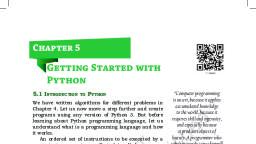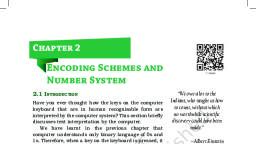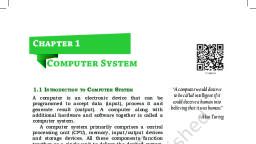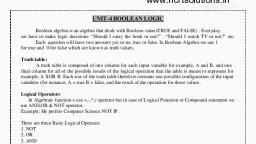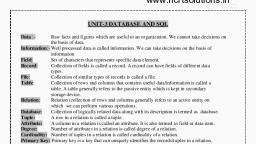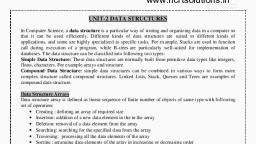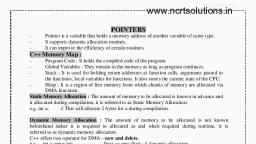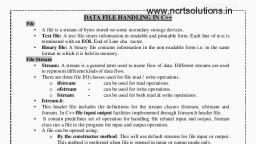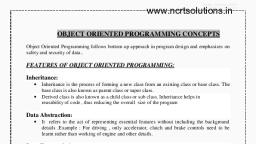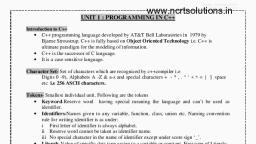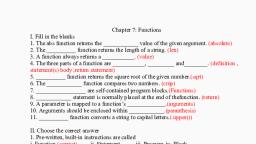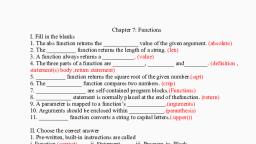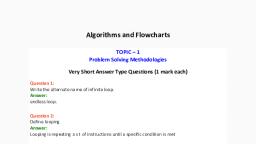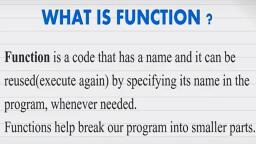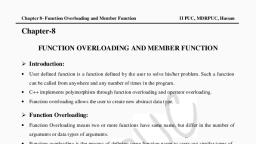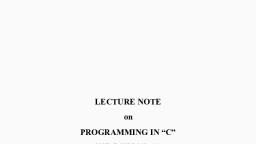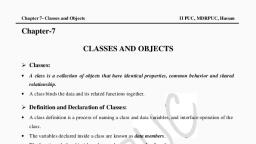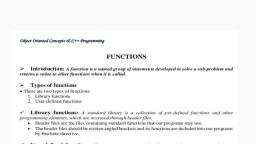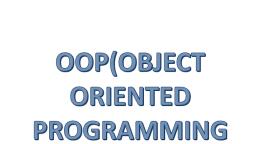Page 1 :
Chapter 7, , Functions, 7.1 Introduction, Till now we have written some programs and might, have realised that as the problem gets complex, the, number of lines in a program increase, which makes the, program look bulky and difficult to manage. Consider, the following problem statement:, There is a company that manufactures tents as per, user’s requirements. The shape of the tent is cylindrical, surmounted by a conical top., , “Once you succeed in writing, the programs for [these], complicated algorithms, they, usually run extremely fast., The computer doesn’t need, to understand the algorithm,, its task is only to run the, programs.”, – R. Tarjan, , Figure 7.1: Shape of a tent, , The company performs the following tasks to fix the, selling price of each tent., 1. Accept user requirements for the tent, such as, a) height, b) radius, c) slant height of the conical part, 2. Calculate the area of the canvas used, 3. Calculate the cost of the canvas used for making, the tent, 4. Calculate the net payable amount by the customer, that is inclusive of the 18% tax, The company has created a computer program for, quick and accurate calculation for the payable amount, as shown in program 7-1., , In this chapter, »» Introduction to, Functions, »» User Defined, Functions, »» Scope of a Variable, »» Python Standard, Library, , 2020-21, Ch 7.indd 143, , 08-Apr-19 12:23:12 PM
Page 2 :
144, , Computer Science – Class, , Program 7-1, , xi, , Program to calculate the payable amount, for the tent., , #Program 7-1, #Program to calculate the payable amount for the tent without, #functions, print( "Enter values for the cylindrical part of the tent in, meters\n"), h = float(input("Enter height of the cylindrical part: ")), r = float(input("Enter radius: ")), l = float(input("Enter the slant height of the conical part in, meters: ")), csa_conical = 3.14*r*l, #Area of conical part, csa_cylindrical = 2*3.14*r*h, #Area of cylindrical part, # Calculate area of the canvas used for making the tent, canvas_area = csa_conical + csa_cylindrical, print("The area of the canvas is",canvas_area,"m^2"), #Calculate cost of the canvas, unit_price = float(input("Enter the cost of 1 m^2 canvas: ")), total_cost= unit_price * canvas_area, print("The total cost of canvas = ",total_cost), #Add tax to the total cost to calculate net amount payable by the, #customer, tax = 0.18 * total_cost;, net_price = total_cost + tax, print("Net amount payable = ",net_price), , Another approach to solve the above problem is, to divide the program into different blocks of code as, shown in Figure 7.2., , Figure 7.2: Calculation of the cost of the tent, , 2020-21, Ch 7.indd 144, , 08-Apr-19 12:23:12 PM
Page 3 :
Functions, , 145, , The process of dividing a computer program into, separate independent blocks of code or separate, sub-problems with different names and specific, functionalities is known as modular programming., In this chapter, we will learn about the benefits of, this approach., , 7.2 Functions, In programming, the use of function is one of the, means to achieve modularity and reusability. Function, can be defined as a named group of instructions that, accomplish a specific task when it is invoked. Once, defined, a function can be called repeatedly from, different places of the program without writing all the, codes of that function everytime, or it can be called from, inside another function, by simply writing the name of, the function and passing the required parameters, if, any (Section 7.3). The programmer can define as many, functions as desired while writing the code. The program, 7-1 is rewritten using user defined functions as shown, in program 7-2., Program 7-2, , Program to calculate the payable, amount for the tent using user, defined functions., , #Program 7-2, #Program to calculate the cost of tent, #function definition, def cyl(h,r):, area_cyl = 2*3.14*r*h, #Area of cylindrical part, return(area_cyl), #function definition, def con(l,r):, area_con = 3.14*r*l, return(area_con), #function definition, def post_tax_price(cost):, tax = 0.18 * cost;, net_price = cost + tax, return(net_price), , #Area of conical part, , #compute payable amount for the tent, , print("Enter values of cylindrical part of the tent in meters:"), h = float(input("Height: ")), r = float(input("Radius: ")), 2020-21, Ch 7.indd 145, , 08-Apr-19 12:23:12 PM
Page 4 :
146, , Computer Science – Class, , csa_cyl = cyl(h,r), , xi, , #function call, , l = float(input("Enter slant height of the conical area in meters: ")), csa_con = con(l,r) #function call, #Calculate area of the canvas used for making the tent, canvas_area = csa_cyl + csa_con, print("Area of canvas = ",canvas_area," m^2"), #Calculate cost of canvas, unit_price = float(input("Enter cost of 1 m^2 canvas in rupees: ")), total_cost = unit_price * canvas_area, print("Total cost of canvas before tax = ",total_cost), print("Net amount payable (including tax) = ",post_tax_price(total_, cost)), , If we compare program 7-1 and 7-2, it is evident that, program 7-2 looks more organised and easier to read., 7.2.1 The Advantages of Function, Suppose in further the company decides to design, another type of tent whose base is rectangular, while, the upper part remains the same. In such a scenario,, some part of the existing code can be reused by calling, the function con(l,r). If the company develops other, products or provides services, and where 18% tax rate, is to be applied, the programmer can use the function, post_tax_price(cost)directly., Thus, following are the advantages of using functions, in a program:, • Increases readability, particularly for longer code, as by using functions, the program is better, organised and easy to understand., • Reduces code length as same code is not required, to be written at multiple places in a program. This, also makes debugging easier., • Increases reusability, as function can be called from, another function or another program. Thus, we can, reuse or build upon already defined functions and, avoid repetitions of writing the same piece of code., • Work can be easily divided among team members, and completed in parallel., , 7.3 User Defined Functions, Taking advantage of reusability feature of functions,, there is a large number of functions already available, , 2020-21, Ch 7.indd 146, , 08-Apr-19 12:23:13 PM
Page 5 :
Functions, , 147, , in Python under standard library (section 7.5). We can, directly call these functions in our program without, defining them. However, in addition to the standard, library functions, we can define our own functions while, writing the program. Such functions are called user, defined functions. Thus, a function defined to achieve, some task as per the programmer's requirement is, called a user defined function., 7.3.1 Creating User Defined Function, A function definition begins with def (short for define)., The syntax for creating a user defined function is, as follows:, , • The items enclosed in "[ ]" are called parameters, and they are optional. Hence, a function may or, may not have parameters. Also, a function may or, may not return a value., • Function header always ends with a colon (:)., • Function name should be unique. Rules for naming, identifiers also applies for function naming., • The statements outside the function indentation, are not considered as part of the function., Program 7-3, , Write a user defined function to add 2 , numbers and display their sum., , #Program 7-3, #Function to add two numbers, #The requirements are listed below:, #1. We need to accept 2 numbers from the user., #2. Calculate their sum, #3. Display the sum., #function definition, def addnum():, fnum = int(input("Enter first number: ")), snum = int(input("Enter second number: ")), sum = fnum + snum, print("The sum of ",fnum,"and ",snum,"is ",sum), #function call, addnum(), , 2020-21, Ch 7.indd 147, , 08-Apr-19 12:23:13 PM
Page 6 :
148, , Computer Science – Class, , xi, , In order to execute the function addnum(), we need, to call it. The function can be called in the program by, writing function name followed by () as shown in the, last line of program 7-3., Output:, Enter first number: 5, Enter second number: 6, The sum of 5 and 6 is 11, , 7.3.2 Arguments and Parameters, In the above example, the numbers were accepted from, the user within the function itself, but it is also possible, for a user defined function to receive values at the time, of being called. An argument is a value passed to the, function during the function call which is received in, corresponding parameter defined in function header., Program 7-4, , Write a program using a user defined, function that displays sum of first n, natural numbers, where n is passed as, an argument., , #Program 7-4, #Program to find the sum of first n natural numbers, #The requirements are:, #1. n be passed as an argument, #2. Calculate sum of first n natural numbers, #3. Display the sum, #function header, def sumSquares(n):, #n is the parameter, sum = 0, for i in range(1,n+1):, sum = sum + i, print("The sum of first",n,"natural numbers is: ",sum), num = int(input("Enter the value for n: ")), #num is an argument referring to the value input by the user, sumSquares(num) , #function call, Argument, num, Parameter, , Let us assume that the user has, input 5 during the execution of the, program 7-4. So, num refers to the value, 5. It is then used as an argument in, the function:, , 5, , n, , Figure 7.3: Both argument and parameter, refers to the same value, , sumSquares(num), , 2020-21, Ch 7.indd 148, , 08-Apr-19 12:23:13 PM
Page 7 :
Functions, , 149, , Since the function is called, the control is transferred, to execute the function, def sumSquares(n):, , where parameter n also refers to the value 5 which, num is referring to as shown in Figure 7.3., Since both num and n are referring to the same value,, they are bound to have the same identity. We can use, the id() function to find the identity of the object that, the argument and parameter are referring to. Let us, understand this with the help of the following example., Program 7-5, , Write a program using user defined, function that accepts an integer and, increments the value by 5. Also display, the id of argument (before function call),, id of parameter before increment and, after increment., , #Program 7-5, #Function to add 5 to a user input number, #The requirements are listed below:, #1. Display the id()of argument before function call., #2. The function should have one parameter to accept the argument, #3. Display the value and id() of the parameter., #4. Add 5 to the parameter, #5. Display the new value and id()of the parameter to check, #whether the parameter is assigned a new memory location or, #not., def incrValue(num):, #id of Num before increment, print("Parameter num has value:",num,"\nid =",id(num)), num = num + 5, #id of Num after increment, print("num incremented by 5 is",num,"\nNow id is ",id(num)), number = int(input("Enter a number: ")), print("id of argument number is:",id(number)), #id of Number, incrValue(number), , Output:, Enter a number: 8, id of argument number is: 1712903328, number and num, Parameter num has value: 8 , have the same id, id = 1712903328 , The id of Num has changed., num incremented by 5 is 13 , Now id is 1712903408, , Let us understand the above output through illustration, (see Figure 7.4):, , 2020-21, Ch 7.indd 149, , 08-Apr-19 12:23:13 PM
Page 8 :
150, , Computer Science – Class, , xi, , Number, Before, increment, , Num, , id, Number, After, increment, , Num, , id, , id, 1712903328, 8, id, 1712903328, , 1712903328, 1712903408, , 8, , 5 added, to 8, 13, , Figure 7.4: ID of argument and parameter before and after increment, , Program 7-6, , Both argument and parameter can have the same, name as shown in program 7-6., Write a program using a user defined, function myMean() to calculate the mean, of floating values stored in a list., , #Program 7-6, #Function to calculate mean, #The requirements are listed below:, #1. The function should have 1 parameter (list containing floating, #point values), #2. To calculate mean by adding all the numbers and dividing by, #total number of elements, , def myMean(myList): #function to compute means of values in list, total = 0, count = 0, for i in myList:, total = total + i, #Adds each element i to total, count = count + 1, #Counts the number of elements, mean = total/count, #mean is calculated, print("The calculated mean is:",mean), myList = [1.3,2.4,3.5,6.9], #Function call with list "myList" as an argument, myMean(myList), , Output:, The calculated mean is: 3.5250000000000004, , Program 7-7, , Write a program using a user defined, function calcFact() to calculate and, display the factorial of a number num, passed as an argument., , 2020-21, Ch 7.indd 150, , 08-Apr-19 12:23:13 PM
Page 9 :
Functions, , 151, , #Program 7-7, #Function to calculate factorial, #The requirements are listed below:, #1. The function should accept one integer argument from user., #2. Calculate factorial. For example:, #3. Display factorial, def calcFact(num):, fact = 1, for i in range(num,0,-1):, fact = fact * i, print("Factorial of",num,"is",fact), num = int(input("Enter the number: ")), calcFact(num), , Output:, Enter the number: 5, Factorial of 5 is 120, Note: Since multiplication is commutative 5! = 5*4*3*2*1 =, 1*2*3*4*5, , (A) String as Parameters, In programs 7-5 to 7-7, the arguments passed are of, numeric type only. However, in some programs, user, may need to pass string values as an argument, as, shown in program 7-8., Program 7-8, , Write a program using a user defined, function that accepts the first name and, lastname as arguments, concatenate, them to get full name and displays the, output as:, , Hello full name, , For example, if first name is Gyan and lastname is, Vardhan, the output should be:, Hello Gyan Vardhan, , #Program 7-8, #Function to display full name, #The requirements are listed below:, #1. The function should have 2 parameters to accept first name and, #last name., #2. Concatenate names using + operator with a space between first, #name and last name., #3. Display full name., , 2020-21, Ch 7.indd 151, , 08-Apr-19 12:23:13 PM
Page 10 :
152, , Computer Science – Class, , xi, , def fullname(first,last):, #+ operator is used to concatenate strings, fullname = first + " " + last, print("Hello",fullname), #function ends here, first = input("Enter first name: "), last = input("Enter last name: "), #function call, fullname(first,last) , , Output:, , Enter first name: Gyan, Enter last name: Vardhan, Hello Gyan Vardhan, , (B) Default Parameter, Python allows assigning a default value to the parameter., A default value is a value that is predecided and assigned, to the parameter when the function call does not have, its corresponding argument., , Program 7-9, , Write a program that accepts numerator, and denominator of a fractional number, and calls a user defined function, mixedFraction() when the fraction, formed is not a proper fraction. The, default value of denominator is 1. The, function displays a mixed fraction only, if the fraction formed by the parameters, does not evaluate to a whole number., , #Program 7-9, #Function to display mixed fraction for an improper fraction, #The requirements are listed below:, #1. Input numerator and denominator from the user., #2. Check if the entered numerator and denominator form a proper, #fraction., #3. If they do not form a proper fraction, then call, #mixedFraction()., #4. mixedFraction()display a mixed fraction only when the fraction, #does not evaluate to a whole number., def mixedFraction(num,deno = 1):, remainder = num % deno, #check if the fraction does not evaluate to a whole number, if remainder!= 0:, quotient = int(num/deno), print("The mixed fraction=", quotient,"(",remainder, "/",, deno,")"), else:, , 2020-21, Ch 7.indd 152, , 08-Apr-19 12:23:13 PM
Page 11 :
Functions, , 153, , print("The given fraction evaluates to a whole number"), #function ends here, num = int(input("Enter the numerator: ")), deno = int(input("Enter the denominator: ")), print("You entered:",num,"/",deno), if num > deno:, #condition to check whether the fraction is, improper, mixedFraction(num,deno), #function call, else:, print("It is a proper fraction"), , Output:, Enter the numerator: 17, Enter the denominator: 2, You entered: 17 / 2, The mixed fraction = 8 ( 1 / 2 ), , In the above program, the denominator entered is 2,, which is passed to the parameter "deno" so the default, value of the argument deno is overwritten., Let us consider the following function call:, mixedFraction(9), , Here, num will be assigned 9 and deno will use the, default value 1., Note:, • A function argument can also be an expression, such as, , mixedFraction(num+5,deno+5), In such a case, the argument is evaluated before calling, the function so that a valid value can be assigned to the, parameter., • The parameters should be in the same order as that of, the arguments., , The default parameters must be the trailing parameters, in the function header that means if any parameter is, having default value then all the other parameters to its, right must also have default values. For example,, def mixedFraction(num,deno = 1), def mixedFraction(num = 2,deno = 1), , Let us consider few more function definition headers:, #incorrect as default must be the last, #parameter, def calcInterest(principal = 1000, rate,, time = 5):, #correct, def calcInterest(rate,principal = 1000,, time = 5):, , 2020-21, Ch 7.indd 153, , 08-Apr-19 12:23:13 PM
Page 12 :
154, , Computer Science – Class, , xi, , 7.3.3 Functions Returning Value, A function may or may not return a value when called., The return statement returns the values from the, function. In the examples given so far, the function, performs calculations and display result(s).They do, not return any value. Such functions are called void, functions. But a situation may arise, wherein we need, to send value(s) from the function to its calling function., This is done using return statement., The return statement does the following:, • returns the control to the calling function., • return value(s) or None., Program 7-10 Write a program using user defined, function calcPow() that accepts base, and exponent as arguments and returns, the value Baseexponent where Base and, exponent are integers., #Program 7-10, #Function to calculate and display base raised to the power exponent, #The requirements are listed below:, #1. Base and exponent are to be accepted as arguments., #2. Calculate Baseexponent, #3. Return the result (use return statement ), #4. Display the returned value., def calcpow(number,power): , #function definition, result = 1, for i in range(1,power+1):, result = result * number, return result, base = int(input("Enter the value for the Base: ")), expo = int(input("Enter the value for the Exponent: ")), answer = calcpow(base,expo) , #function call , print(base,"raised to the power",expo,"is",answer), , Output:, Enter the value for the Base: 5, Enter the value for the Exponent: 4, 5 raised to the power 4 is 625, , So far we have learnt that a function may or may, not have parameter(s) and a function may or may not, return any value(s). In Python, as per our requirements,, we can have the function in either of the following ways:, • Function with no argument and no return value, • Function with no argument and with return value(s), • Function with argument(s) and no return value, 2020-21, , Ch 7.indd 154, , 08-Apr-19 12:23:13 PM
Page 13 :
Functions, , 155, , • Function with argument(s) and return value(s), 7.3.4 Flow of Execution, Flow of execution can be defined as the order in which, the statements in a program are executed. The Python, interpreter starts executing the instructions in a, program from the first statement. The statements are, executed one by one, in the order of appearance from, top to bottom., When the interpreter encounters a function definition,, the statements inside the function are not executed, until the function is called. Later, when the interpreter, encounters a function call, there is a little deviation, in the flow of execution. In that case, instead of going, to the next statement, the control jumps to the called, function and executes the statement of that function., After that, the control comes back the point of function, call so that the remaining statements in the program, can be executed. Therefore, when we read a program,, we should not simply read from top to bottom. Instead,, we should follow the flow of control or execution. It is, also important to note that a function must be defined, before its call within a program., Program 7-11 Program to understand the low of , execution using functions., #Program 7-11, #print using functions, helloPython(), , #Function Call, , def helloPython():, print("I love Programming"), , #Function definition, , On executing the above code the following error is, produced:, , Traceback (most recent call last):, File "C:\NCERT\Prog 7-11.py", line 3, in <module>, helloPython(), #Function Call, NameError: name 'helloPython' is not defined, , The error ‘function not defined’ is produced even, though the function has been defined. When a function, call is encountered, the control has to jump to the, function definition and execute it. In the above program,, since the function call precedes the function definition,, the interpreter does not find the function definition and, hence an error is raised., 2020-21, Ch 7.indd 155, , 08-Apr-19 12:23:13 PM
Page 14 :
156, , Computer Science – Class, , xi, , That is why, the function definition should be made, before the function call as shown below:, def helloPython(): #Function definition, print("I love Programming"), helloPython(), , #Function Call, , [2], , def Greetings(Name):, , #Function Header, , [1], , Greetings("John"), , #Function Call, , [3], , print("Hello "+Name), , [4], , print("Thanks"), def RectangleArea(l,b):, , [4], [5], , return l*b, , [1], , l = input("Length: "), , [3][6], , Area = RectangleArea(l,b), , [2], [7], [8], , #Function Header, , b = input("Breadth: "), , #Function Call, , print(Area), print("thanks"), Figure 7.5: Order of execution of statements, , Figure 7.5 explains, the flow of execution, for two programs. The, number in square, brackets shows the, order of execution of, the statements., Sometime,, a, function needs to, return, multiple, values which may be, returned using tuple., Program 7-12 shows, a function which, returns two values, area and perimeter of, rectangle using tuple., , Program 7-12 Write a program using user defined, function that accepts length and breadth, of a rectangle and returns the area and, perimeter of the rectangle., #Program 7-12, #Function to calculate area and perimeter of a rectangle, #The requirements are listed below:, #1. The function should accept 2 parameters., #2. Calculate area and perimeter., #3. Return area and perimeter., def calcAreaPeri(Length,Breadth):, area = length * breadth, perimeter = 2 * (length + breadth), #a tuple is returned consisting of 2 values area and perimeter, return (area,perimeter), l = float(input("Enter length of the rectangle: ")), b = float(input("Enter breadth of the rectangle: ")), #value of tuples assigned in order they are returned, area,perimeter = calcAreaPeri(l,b), print("Area is:",area,"\nPerimeter is:",perimeter), , 2020-21, Ch 7.indd 156, , 08-Apr-19 12:23:13 PM
Page 15 :
Functions, , 157, , Output:, Enter Length of the rectangle: 45, Enter Breadth of the rectangle: 66, Area is: 2970.0, Perimeter is: 222.0, , Multiple values in, Python are returned, through a tuple. (Ch. 10), , Program 7-13 Write a program that simulates a traffic, light . The program should consist of the, following:, 1. A user defined function trafficLight( ) that accepts, input from the user, displays an error message, if the user enters anything other than RED,, YELLOW, and GREEN. Function light() is called, and following is displayed depending upon return, value from light()., a) “STOP, your life is precious” if the value, returned by light() is 0., b) “Please WAIT, till the light is Green “ if the, value returned by light() is 1, c) “GO! Thank you for being patient” if the value, returned by light() is 2., 2. A user defined function light() that accepts a string, as input and returns 0 when the input is RED,, 1 when the input is YELLOW and 2 when the, input is GREEN. The input should be passed as, an argument., 3. Display “ SPEED THRILLS BUT KILLS” after the, function trafficLight( ) is executed., #Program 7-13, #Function to simulate a traffic light, #It is required to make 2 user defined functions trafficLight() and, #light()., def trafficLight():, signal = input("Enter the colour of the traffic light: "), if (signal not in ("RED","YELLOW","GREEN")):, print("Please enter a valid Traffic Light colour in, CAPITALS"), else:, value = light(signal), #function call to light(), if (value == 0):, print("STOP, Your Life is Precious."), elif (value == 1):, print ("PLEASE GO SLOW."), else:, , 2020-21, Ch 7.indd 157, , 08-Apr-19 12:23:13 PM, , M, Py, th
Page 16 :
158, , Computer Science – Class, , xi, , print("GO!,Thank you for being patient."), #function ends here, def light(colour):, if (colour == "RED"):, return(0);, elif (colour == "YELLOW"):, return (1), else:, return(2), #function ends here, trafficLight(), print("SPEED THRILLS BUT KILLS"), , Output:, , Enter the colour of the traffic light: YELLOW, PLEASE GO SLOW., SPEED THRILLS BUT KILLS, , 7.4 Scope, , of a, , Variable, , A variable defined inside a function cannot be, accessed outside it. Every variable has a well-defined, Variable, accessibility. The part of the program where a, Scope, variable is accessible can be defined as the scope, of that variable. A variable can have one of the, Local, Global, following two scopes:, Scope, Scope, A variable that has global scope is known as a, global variable and a variable that has a local scope, Figure 7.6: Scope of a variable, is known as a local variable., (A) Global Variable, In Python, a variable that is defined outside any function, or any block is known as a global variable. It can be, accessed in any functions defined onwards. Any change, made to the global variable will impact all the functions, in the program where that variable can be accessed., (B) Local Variable, A variable that is defined inside any function or a block, is known as a local variable. It can be accessed only in, the function or a block where it is defined. It exists only, till the function executes., , 2020-21, Ch 7.indd 158, , 08-Apr-19 12:23:13 PM
Page 17 :
Functions, , 159, , Program 7-14 Program to access any variable outside, the function, #Program 7-14, #To access any variable outside the function, num = 5, def myFunc1( ):, y = num + 5, print("Accessing num -> (global) in myFunc1, value = ",num), print("Accessing y-> (local variable of myFunc1) accessible, value=",y), myFunc1(), print("Accessing num outside myFunc1 ",num), print("Accessing y outside myFunc1 ",y), Output:, Accessing num -> (global) in myFunc1, value = 5, Accessing y-> (local variable of myFunc1) accessible, value = 10, Accessing num outside myFunc1 5, Traceback (most recent call last):, File "C:\NCERT\Prog 7-14.py", line 9, in <module>, y generates error when it is, print("Accessing y outside myFunc1 ",y), accessed outside myfunc1(), NameError: name ‘y’ is not defined, , Global variable output,, , Local variable output, , Note:, • Any modification to global variable is permanent and, affects all the functions where it is used., •, •, , If a variable with the same name as the global variable, is defined inside a function, then it is considered local, to that function and hides the global variable., If the modified value of a global variable is to be used, outside the function, then the keyword global should, be prefixed to the variable name in the function., , Program 7-15, , Write a program to access any variable, outside the function., , #Program 7-15, #To access any variable outside the function, , num = 5, def myfunc1():, #Prefixing global informs Python to use the updated global, #variable num outside the function, global num, print("Accessing num =",num), num = 10, print("num reassigned =",num), #function ends here, myfunc1(), print("Accessing num outside myfunc1",num), , 2020-21, Ch 7.indd 159, , 08-Apr-19 12:23:13 PM
Page 18 :
160, , Computer Science – Class, , Output:, , xi, , Global variable num is accessed as the ambiguity is resolved by, , Accessing num = 5, prefixing global to it, num reassigned = 10, Accessing num outside myfunc1 10, , 7.5 Python Standard Library, Built-in, Standard Library, Module, , Function, User Defined, , Figure 7.7: Types of functions, , Python has a very extensive, standard library. It is a, collection of many built, in functions that can be, called in the program as, and when required, thus, saving programmer’s time, of creating those commonly, used functions everytime., , 7.5.1 Built-in functions, Built-in functions are the ready-made functions in, Python that are frequently used in programs. Let us, inspect the following Python program:, #Program to calculate square of a number, a = int(input("Enter a number: "), b = a * a, print(" The square of ",a ,"is", b), , In the above program input(), int() and print(), are the built-in functions. The set of instructions to be, executed for these built-in functions are already defined, in the python interpreter., Let us consider the following Python statement, consisting of a function call to a built in function and, answer the given questions:, fname = input("Enter your name: "), , What is the name of the function being used?, • input(), , Does the function accept a value or argument?, • Yes, because the parenthesis "()" consists of a, string "Enter your name"., Does the function return a value?, • Yes, since there is an assignment (=) operator, preceding the function name, it means that the, function returns a value which is stored in the, variable fname., Hence, the function input() accepts a value and, returns a value., , 2020-21, Ch 7.indd 160, , 08-Apr-19 12:23:13 PM
Page 19 :
Functions, , 161, , Now consider the built-in functions int() and print(),, and answer the questions below:, • Does the function accept a value or argument?, • Does the function return a value?, Following is a categorised list of some of the, frequently used built-in functions in Python:, Built-in Functions, Input or Output, , Datatype, Conversion, , Mathematical, Functions, , Other Functions, , input(), , bool(), , abs(), , __import__(), , print(), , chr(), , divmod(), , len(), , dict(), , max(), , range(), , float(), , min(), , type(), , int(), , pow(), , list(), , sum(), , ord(), set(), str(), tuple(), , We have already used some of the built-in functions., Let us get familiar with some of them as explained in, Table 7.1., Table 7.1 Commonly used built-in functions, Function, Syntax, abs(x), , divmod(x,y), , max(sequence), or, max(x,y,z,...), , Arguments, , Returns, , Example, Output, , x may be an integer Absolute value of x, or floating point, number, , >>> abs(4), 4, >>> abs(-5.7), 5.7, >>> divmod(7,2), x and y are integers A tuple:, (quotient, remainder) (3, 1), >>> divmod(7.5,2), (3.0, 1.5), >>> divmod(-7,2), (-4, 1), >>> max([1,2,3,4]), x,y,z,.., may, be Largest number, 4, integer or floating in the sequence/, point number, largest of two or, >>> max("Sincerity"), more arguments, 'y' #Based on ASCII value, , 2020-21, Ch 7.indd 161, , 08-Apr-19 12:23:13 PM
Page 20 :
162, , Computer Science – Class, , min(sequence), or, min(x,y,z,...), , pow(x,y[,z]), , sum(x[,num]), , xi, , >>> max(23,4,56), 56, >>> min([1,2,3,4]), x, y, z,.. may be Smallest number, 1, integer or floating in the sequence/, point number, smallest of two or, >>> min("Sincerity"), more arguments, 'S', #Uppercase letters have, lower ASCII values than, lowercase letters., >>> min(23,4,56), 4, y, >>> pow(5,2), x, y, z may be x (x raised to the, 25.0, integer or floating power y), point number, if z is provided, then: >>> pow(5.3,2.2), (xy ) % z, 39.2, >>> pow(5,2,4), 1, >>> sum([2,4,7,3]), x is a numeric Sum of all the, 16, sequence and num elements in the, is, an, optional sequence from left to >>> sum([2,4,7,3],3), argument, right., 19, if given parameter,, >>> sum((52,8,4,2)), num is added to the, 66, sum, , len(x), , x can be a sequence Count of elements, or a dictionary, in x, , >>> len(“Patience”), 8, >>> len([12,34,98]), 3, >>> len((9,45)), 2 >>>len({1:”Anuj”,2:”Razia”,, 3:”Gurpreet”,4:”Sandra”}), 4, , 7.5.2 Module, Other than the built-in functions, the Python standard, library also consists of a number of modules. While, a function is a grouping of instructions, a module, is a grouping of functions. As we know that when a, program grows, function is used to simplify the code, and to avoid repetition. For a complex problem, it may, not be feasible to manage the code in one single file., Then, the program is divided into different parts under, different levels, called modules. Also, suppose we have, created some functions in a program and we want to, reuse them in another program. In that case, we can, save those functions under a module and reuse them., A module is created as a python (.py) file containing a, collection of function definitions., , 2020-21, Ch 7.indd 162, , 08-Apr-19 12:23:13 PM
Page 21 :
Functions, , 163, , To use a module, we need to import the module. Once, we import a module, we can directly use all the functions, of that module. The syntax of import statement is as, follows:, import modulename1 [,modulename2, …], , This gives us access to all the functions in the, module(s). To call a function of a module, the function, name should be preceded with the name of the module, with a dot(.) as a separator., The syntax is as shown below:, modulename.functionname(), , (A) Built-in Modules, Python library has many built-in modules that are really, handy to programmers. Let us explore some commonly, used modules and the frequently used functions that, are found in those modules:, • math, • random, • statistics, , Remember, Python is case, sensitive. All the module, names are in lowercase., , 1. Module name : math, It contains different types of mathematical functions., Most of the functions in this module return a float value., Some of the commonly used functions in math module, are given in Table 7.2. In order to use the math module, we need to import it using the following statement:, import math, Table 7.2 Commonly used functions in math module, Function, Syntax, , Arguments, , Returns, , Example, Output, , math.ceil(x), , x may be an integer or, floating point number, , ceiling value of x, , >>> math.ceil(-9.7), -9, >>> math.ceil (9.7), 10, >>> math.ceil(9), 9, , math.floor(x), , x may be an integer or, floating point number, , floor value of x, , >>> math.floor(-4.5), -5, >>> math.floor(4.5), 4, >>> math.floor(4), 4, , 2020-21, Ch 7.indd 163, , 08-Apr-19 12:23:14 PM
Page 22 :
164, , Computer Science – Class, , xi, , x may be an integer or, floating point number, , absolute value of x, , >>> math.fabs(6.7), 6.7, >>> math.fabs(-6.7), 6.7, >>> math.fabs(-4), 4.0, , x is a positive integer, , factorial of x, , >>> math.factorial(5), 120, , math.fmod(x,y), , x and y may be an, integer or floating point, number, , x % y with sign of x, , >>> math.fmod(4,4.9), 4.0, >>> math.fmod(4.9,4.9), 0.0, >>> math.fmod(-4.9,2.5), -2.4, >>> math.fmod(4.9,-4.9), 0.0, , math.gcd(x,y), , x, y are positive integers, , gcd (greatest common, divisor) of x and y, , >>> math.gcd(10,2), 2, , math.pow(x,y), , x, y may be an integer or, floating point number, , xy (x raised to the, power y), , >>> math.pow(3,2), 9.0, >>> math.pow(4,2.5), 32.0, >>> math.pow(6.5,2), 42.25, >>> math.pow(5.5,3.2), 233.97, , math.sqrt(x), , x may be a positive, integer or floating point, number, , square root of x, , >>> math.sqrt(144), 12.0, >>> math.sqrt(.64), 0.8, , math.sin(x), , x may be an integer or, floating point number in, radians, , sine of x in radians, , >>> math.sin(0), 0, >>> math.sin(6), -0.279, , math.fabs(x), , math.factorial(x), , 2. Module name : random, This module contains functions that are used for, generating random numbers. Some of the commonly, used functions in random module are given in Table, 7.3. For using this module, we can import it using the, following statement:, import random, Table 7.3 Commonly used functions in random module, Function, Syntax, random.random(), , Argument, No argument, (void), , Return, Random, Real Number, (float) in the, range, 0.0 to 1.0, , Example, Output, >>> random.random(), 0.65333522, , 2020-21, Ch 7.indd 164, , 08-Apr-19 12:23:14 PM
Page 23 :
Functions, random., randint(x,y), , x, y are, such that, x <= y, , integers, , Random integer, between x and y, , random., randrange(y), , y is a positive integer, signifying the stop, value, , Random integer, between 0 and y, , >>> random.randrange(5), 4, , random., randrange(x,y), , x and y are positive, integers signifying, the start and stop, value, , Random integer, between x and y, , >>> random.randrange(2,7), 2, , 165, , >>> random.randint(3,7), 4, >>> random.randint(-3,5), 1, >>> random.randint(-5,-3), -5.0, , 3. Module name : statistics, This module provides functions for calculating statistics, of numeric (Real-valued) data. Some of the commonly, used functions in st atist ics module are given in, Table 7.4. It can be included in the program by using, the following statements:, import statistics, Table 7.4 Some of the function available through statistics module, Function Syntax, , Argument, , Return, , Example, Output, , statistics.mean(x), , x is a numeric, sequence, , arithmetic, mean, , >>> statistics., mean([11,24,32,45,51]), 32.6, , statistics.median(x), , x is a numeric, sequence, , median, (middle, value) of x, , >>>statistics., median([11,24,32,45,51]), 32, , statistics.mode(x), , x is a sequence, , mode, (the most, repeated, value), , >>> statistics., mode([11,24,11,45,11]), 11, >>> statistics., mode(("red","blue","red")), 'red', , Note:, • import statement can be written anywhere in the, program, •, , Module must be imported only once, , •, , In order to get a list of modules available in Python, we, can use the following statement:, >>> help("module"), , •, , To view the content of a module say math, type the, following:, >>> help("math"), , 2020-21, Ch 7.indd 165, , 08-Apr-19 12:23:14 PM
Page 24 :
166, , Computer Science – Class, , xi, , Figure 7.8: Content of module "math", , •, , The modules in the standard library can be found in, the Lib folder of Python., , (B) From Statement, Instead of loading all the functions into memory by, importing a module, from statement can be used to, access only the required functions from a module. It, loads only the specified function(s) instead of all the, functions in a module., Its syntax is, >>> from modulename import functionname [,, functionname,...], , To use the function when imported using "from, statement" we do not need to precede it with the module, name. Rather we can directly call the function as shown, in the following examples:, Example 7.5, >>> from random import random, >>> random(), #Function called without, the module name, Good Programming, Practice: Only using, the required function(s), rather than importing a, module saves memory., , Output:, 0.9796352504608387, , Example 7.6, >>> from math import ceil,sqrt, >>> value = ceil(624.7), >>> sqrt(value), , Output:, 25.0, , In example 7.2, the ceil value of 624.7 is stored in the, variable "value" and then sqrt function is applied on the, , 2020-21, Ch 7.indd 166, , 08-Apr-19 12:23:14 PM
Page 25 :
Functions, , 167, , variable "value". The above example can be rewritten as:, >>> sqrt(ceil(624.7)), , The execution of the function sqrt() is dependent, on the output of ceil() function., If we want to extract the integer part of 624.7 (we will, use trunc() function from math module), we can use, the following statements., #ceil and sqrt already been imported above, >>> from math import trunc, >>> sqrt(trunc(625.7)), , Output:, 25.0, , A programming statement wherein the functions or, expressions are dependent on each other’s execution, for achieving an output is termed as composition, here, are some other examples of composition:, • a = int(input("First number: ")), , • print("Square root of ",a ," = ",math.sqrt(a)), • print(floor(a+(b/c))), , • math.sin(float(h)/float(c)), , Besides the available modules in Python standard, library, we can also create our own module consisting, of our own functions., Program 7-16, , Create a user defined module basic_, math that contains the following user, defined functions:, , 1., 2., 3., 4., , To add two numbers and return their sum., To subtract two numbers and return their difference., To multiply two numbers and return their product., To divide two numbers and return their quotient, and print “Division by Zero” error if the denominator, is zero., 5. Also add a docstring to describe the module. After, creating module, import and execute functions., , """Docstrings""" is, also called Python, documentation strings., It is a multiline comment, that is added to describe, the modules, functions,, etc. They are typically, added as the first line,, using 3 double quotes., , #Program 7-16, #The requirement is:, #1. Write a docstring describing the module., #2. Write user defined functions as per the specification., #3. Save the file., #4. Import at shell prompt and execute the functions., , 2020-21, Ch 7.indd 167, , 08-Apr-19 12:23:14 PM
Page 26 :
168, , Computer Science – Class, , xi, , """, basic_math Module, *******************, This module contains basic arithmetic operations, that can be carried out on numbers, """, #Beginning of module, def addnum(x,y):, return(x + y), def subnum(x,y):, return(x - y), def multnum(x,y):, return(x * y), def divnum(x,y):, if y == 0:, print ("Division by Zero Error"), else:, return (x/y) , #End of module, , Output:, #Statements for using module basic_math, >>> import basic_math, #Display descriptions of the said module, >>> print(basic_math.__doc__), basic_math Module, *******************, This module contains basic arithmetic operations, that can be carried out on numbers, >>> a = basic_math.addnum(2,5), >>> a, 7, >>> a = basic_math.subnum(2,5), >>> a, -3, >>> a = basic_math.multnum(2,5), >>> a, 10, >>> a = basic_math.divnum(2,5), >>> a, 0.4, >>> a = basic_math.divnum(2,0), Zero Divide Error, , #Call addnum() function of the, #basic_math module, #Call subnum() function of the, #basic_ math module, #Call multnum() function of the, #basic_math module, #Call divnum() function of the, #basic_math module, #Call divnum() function of the, #basic_math module, , __doc__ variable stores the docstring. To display docstring of a module we, need to import the module and type the following:, print(<modulename>.__doc__), , #__ are 2 underscore without space, , 2020-21, Ch 7.indd 168, , 08-Apr-19 12:23:14 PM
Page 27 :
Functions, , 169, , Notes, , Summary, • In programming, functions are used to achieve, modularity and reusability., • Function can be defined as a named group of, instructions that are executed when the function, is invoked or called by its name. Programmers, can write their own functions known as user, defined functions., • The Python interpreter has a number of functions, built into it. These are the functions that are, frequently used in a Python program. Such functions, are known as built-in functions., • An argument is a value passed to the function, during function call which is received in a parameter, defined in function header., • Python allows, the parameter., , assigning, , a, , default, , value, , to, , • A function returns value(s) to the calling function, using return statement., • Multiple values in Python are returned through, a Tuple., • Flow of execution can be defined as the order in, which the statements in a program are executed., • The part of the program where a variable is accessible, is defined as the scope of the variable., • A variable that is defined outside any particular, function or block is known as a global variable. It, can be accessed anywhere in the program., • A variable that is defined inside any function or block, is known as a local variable. It can be accessed only, in the function or block where it is defined. It exists, only till the function executes or remains active., • The Python standard library is an extensive, collection of functions and modules that help the, programmer in the faster development of programs., • A module is a Python file that contains definitions of, multiple functions., • A module can be imported in a program using, import statement., • Irrespective of the number of times a module is, imported, it is loaded only once., • To import specific functions in a program from a, module, from statement can be used., , 2020-21, Ch 7.indd 169, , 08-Apr-19 12:23:14 PM
Page 28 :
170, , Computer Science – Class, , Notes, , xi, , Exercise, 1. Observe the following programs carefully, and, identify the error:, a) def create (text, freq):, , for i in range (1, freq):, print text, , create(5), , #function call, , b) from math import sqrt,ceil, def calc():, print cos(0), calc(), c), , #function call, , mynum = 9, , def add9():, , mynum = mynum + 9, print mynum, , add9(), , #function call, , d) def findValue( vall = 1.1, val2, val3):, final = (val2 + val3)/ vall, print(final), , findvalue(), e), , def greet():, , #function call, , return("Good morning"), , greet() = message, , #function call, , 2. How is math.ceil(89.7) different from math.floor, (89.7)?, 3. Out of random() and randint(), which function, should we use to generate random numbers between, 1 and 5. Justify., 4. How is built-in function pow() function different from, function math.pow() ? Explain with an example., 5. Using an example show how a function in Python, can return multiple values., 6. Differentiate between following with the help of an, example:, a) Argument and Parameter, b) Global and Local variable, 7. Does a function always return a value? Explain with, an example., , 2020-21, Ch 7.indd 170, , 08-Apr-19 12:23:14 PM
Page 29 :
Functions, , Activity-based Questions, , 171, , Notes, , Note: Writing a program implies:, •, , Adding comments as part of documentation, , •, , Writing function definition, , •, , Executing the function through a function call, , 1. To secure your account, whether it be an email,, online bank account or any other account, it is, important that we use authentication. Use your, programming expertise to create a program using, user defined function named login that accepts, userid and password as parameters (login(uid,pwd)), that displays a message “account blocked” in case of, three wrong attempts. The login is successful if the, user enters user ID as "ADMIN" and password as, "St0rE@1". On successful login, display a message, “login successful”., 2. XYZ store plans to give festival discount to its, customers. The store management has decided to, give discount on the following criteria:, Shopping Amount, , Discount Offered, , >=500 and <1000, , 5%, , >=1000 and <2000, , 8%, , >=2000, , 10%, , An additional discount of 5% is given to customers, who are the members of the store. Create a program, using user defined function that accepts the shopping, amount as a parameter and calculates discount and net, amount payable on the basis of the following conditions:, Net Payable Amount = Total Shopping Amount –, Discount., 3. ‘Play and learn’ strategy helps toddlers understand, concepts in a fun way. Being a senior student you, have taken responsibility to develop a program using, user defined functions to help children master two, and three-letter words using English alphabets and, addition of single digit numbers. Make sure that you, perform a careful analysis of the type of questions, that can be included as per the age and curriculum., , 2020-21, Ch 7.indd 171, , 08-Apr-19 12:23:14 PM
Page 30 :
172, , Computer Science – Class, , Notes, , xi, , 4. Take a look at the series below:, 1, 1, 2, 3, 5, 8, 13, 21, 34, 55…, To form the pattern, start by writing 1 and 1., Add them together to get 2. Add the last two, numbers: 1+2 = 3.Continue adding the previous, two numbers to find the next number in the series., These numbers make up the famed Fibonacci, sequence: previous two numbers are added to get, the immediate new number., 5. Create a menu driven program using user defined, functions to implement a calculator that performs, the following:, a) Basic arithmetic operations(+,-,*,/), b) log10(x),sin(x),cos(x), , Suggested Lab. Exercises, 1. Write a program to check the divisibility of a, number by 7 that is passed as a parameter to the, user defined function., 2. Write a program that uses a user defined function, that accepts name and gender (as M for Male,, F for Female) and prefixes Mr/Ms on the basis of, the gender., 3. Write a program that has a user defined function, to accept the coefficients of a quadratic equation, in variables and calculates its determinant. For, example : if the coefficients are stored in the, variables a,b,c then calculate determinant as, b2-4ac. Write the appropriate condition to check, determinants on positive, zero and negative and, output appropriate result., 4. ABC School has allotted unique token IDs from (1 to, 600) to all the parents for facilitating a lucky draw, on the day of their Annual day function. The winner, would receive a special prize. Write a program using, Python that helps to automate the task.(Hint: use, random module), 5. Write a program that implements a user defined, function that accepts Principal Amount, Rate,, Time, Number of Times the interest is compounded, to calculate and displays compound interest., (Hint: CI = ((P*(1+R/N))NT), , 2020-21, Ch 7.indd 172, , 08-Apr-19 12:23:14 PM
Page 31 :
Functions, , 6. Write a program that has a user defined function, to accept 2 numbers as parameters, if number 1, is less than number 2 then numbers are swapped, and returned, i.e., number 2 is returned in place, of number1 and number 1 is reformed in place of, number 2, otherwise the same order is returned., , 173, , Notes, , 7. Write a program that contains user defined, functions to calculate area, perimeter or surface, area whichever is applicable for various shapes, like square, rectangle, triangle, circle and cylinder., The user defined functions should accept the values, for calculation as parameters and the calculated, value should be returned. Import the module and, use the appropriate functions., 8. Write a program that creates a GK quiz consisting, of any five questions of your choice. The questions, should be displayed randomly. Create a user defined, function score() to calculate the score of the quiz and, another user defined function remark (scorevalue), that accepts the final score to display remarks as, follows:, Marks, , Remarks, , 5, , Outstanding, , 4, , Excellent, , 3, , Good, , 2, , Read more to score more, , 1, , Needs to take interest, , 0, , General knowledge will always help you. Take it seriously., , Case Study-based Question, For the SMIS system extended in Chapter 6 let us do, the following:, 1. 7.1 Convert all the functionality in Chapter 5 and 6, using user defined functions., 2. 7.2 Add another user defined function to the above, menu to check if the student has short attendance, or not. The function should accept total number of, working days in a month and check if the student, is a defaulter by calculating his or her attendance, using the formula: Count of days the student was, , 2020-21, Ch 7.indd 173, , 08-Apr-19 12:23:14 PM
Page 32 :
174, , Computer Science – Class, , Notes, , xi, , present or the total number of working days. In case, the attendance calculated is less than 78%, the, function should return 1 indicating short attendance, otherwise the function should return 0 indicating, attendance is not short., Let’s peer review the case studies of others based on, the parameters given under “DOCUMENTATION TIPS”, at the end of Chapter 5 and provide a feedback to them., , 2020-21, Ch 7.indd 174, , 08-Apr-19 12:23:14 PM





